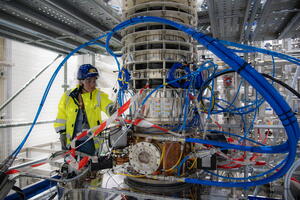First gyrotron ready for commissioning
Teams onsite have completed the installation of the first ITER gyrotron and commissioning tests will start later this month. The microwave-generating device, supplied by Japan, is the first of 24 gyrotrons to be installed on the top floor of the Radiofrequency Building and one of 72 gyrotrons overall that will be needed when scientists introduce tritium for the first time into the ITER device (a scientific phase called DT-1).
Referred to as "plasma starters" for their role in initiating plasma pulses or "wave generators" for their efficiency at generating high-frequency waves to match the resonant frequency of electrons in the plasma (170 GHz), gyrotrons are a critical part of auxiliary heating at ITER. Electron cyclotron resonance heating (ECRH) heats the electrons in the plasma; the electrons in turn transfer the absorbed energy to the ions by collision.
The original baseline plan for ITER called for 24 gyrotron devices (8 from Japan, 8 from Russia, 6 from Europe and 2 from India). The first sixteen from Japan and Russia have passed all factory acceptance testing and been delivered to ITER. One by one, teams will install them in the Radiofrequency Building's "gyrotron floor" (level 3).
The new baseline, which demands more powerful radiowave plasma heating, has modified plans both for gyrotron procurement and for the Radiofrequency Building. Forty-eight gyrotrons will now be required at the start of ITER operation and another 24 for the first phase of deuterium-tritium plasma operation (DT-1). This requires additional procurement, an annex to the Radiofrequency Building, and an entirely separate building for equipment for the ion cyclotron resonance heating system.
In a milestone for the radiofrequency heating program, the installation of the first gyrotron procured by the Japanese Domestic Agency is now complete. It has been connected to its power supply and commissioning is forecast to begin later this month. One of the highlights of commissioning will be the generation of the first radiofrequency waves.


